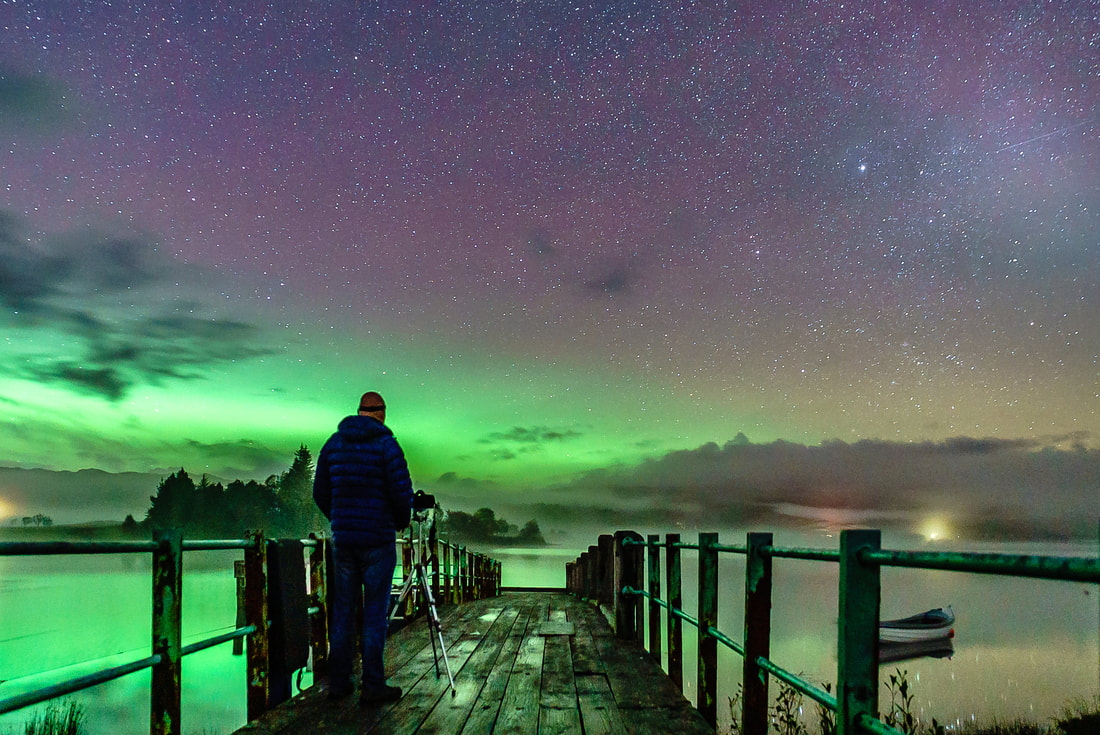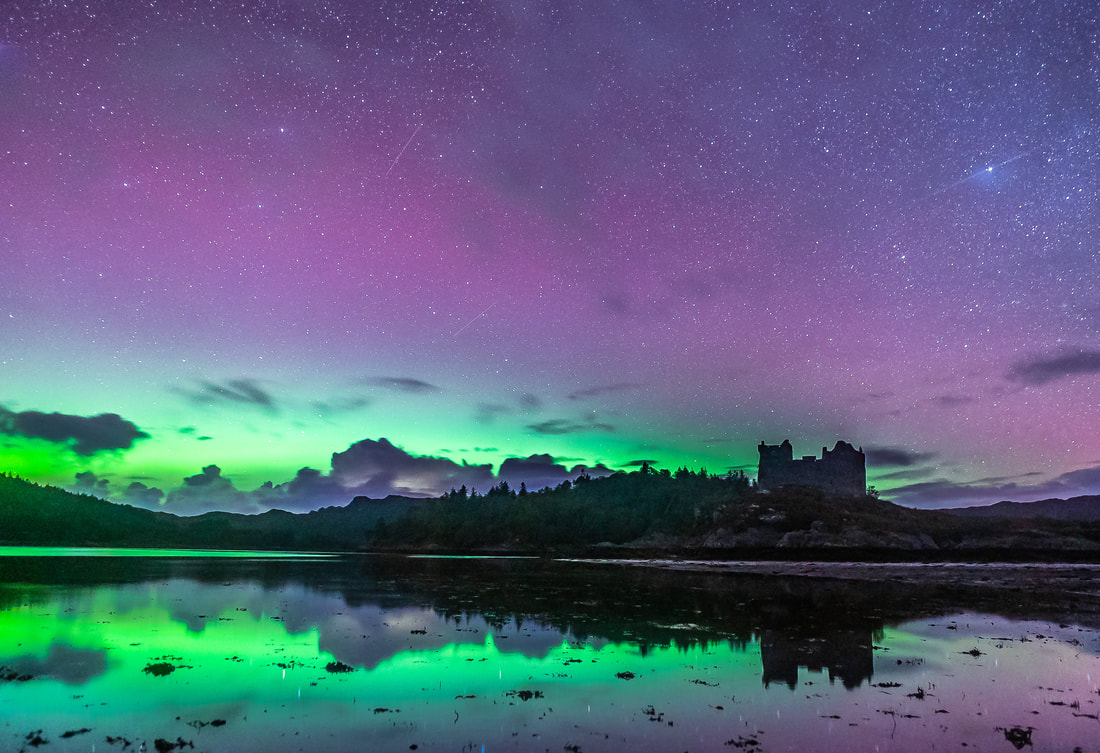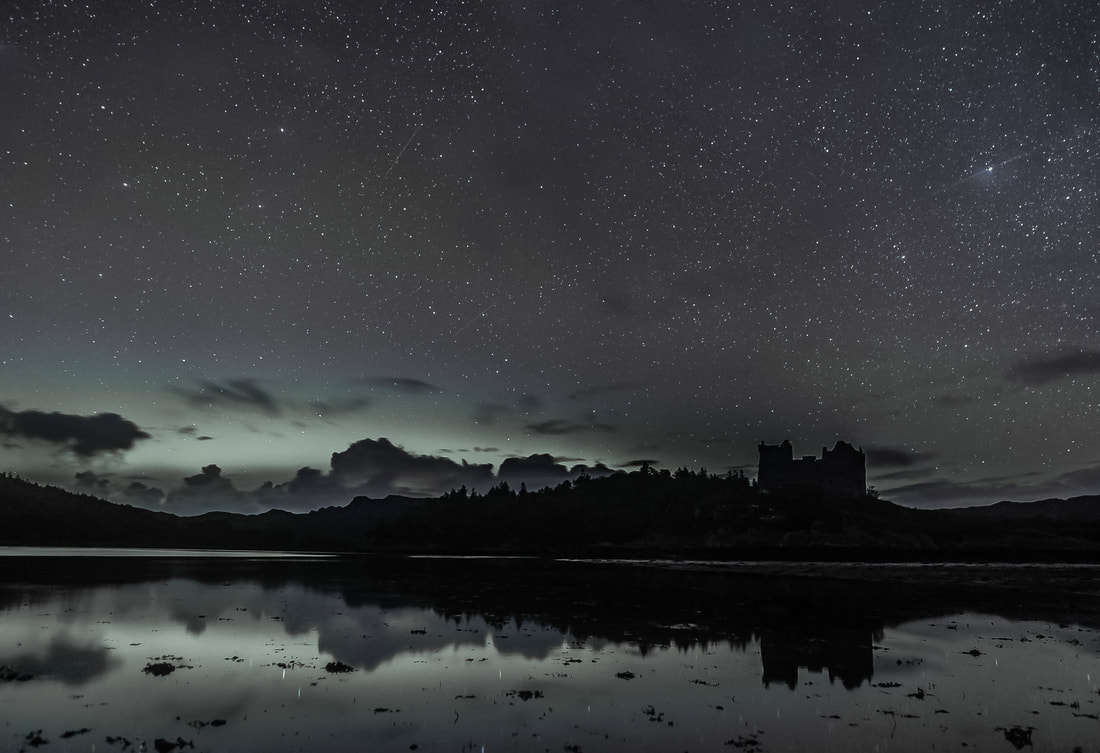|
The image below was taken on a September night at the Loch Shiel jetty in Acharacle when I had a client with me for some night photography tuition. We had been photographing the Milky Way in the sky over Loch Sunart when the Aurora Alerts went off, so we decided to head over to the jetty as it has a clear view north. We had a great time photographing the Northern Lights both here and at other locations close by. Some of the images from that night hang in my Studio at Resipole and they often prompt people to ask; “Can you see the Northern Lights here and are they really that green?”. My answer is always yes, but we can only perceive the aurora as a greyish-blue light. I then go on to explain the reason why... It’s all because our eyes contain two types of photoreceptors (cones and rods) and how they work in the dark compared to how they work in daylight. Each retina has about 6 to 7 million cones and they provide the eye with the ability to distinguish colour. However, these cones only work effectively when it is light. On the other hand, there are about 120 million rods. These are far more effective at helping us to see in low light and near dark conditions, but they cannot distinguish colour. So, as it gets dark and the cones stop working, our eyes move from enabling us to see in full colour to only seeing in black and white. This means that anything we look at in the dark, including the Northern Lights, will only be seen in black, white and shades of grey. However, the sensors that you find in digital cameras do not suffer from this limitation and are extremely effective at picking up both light and colour in the dark. They can easily pick up the greens, reds, blues and purples that are present in the aurora, meaning that the colours you see in digitally taken images of the aurora are not a result of any photo editing but are, in fact, real. The auroral colours are a result of collisions between gaseous particles in the Earth's atmosphere and charged particles released from the Sun's atmosphere. The colours present in the aurora depend on the type of gas particles the charged solar particles collide with. Green is the most common because most solar particles collide with our atmosphere at an altitude of around 60 to 150 miles, where there are high concentrations of oxygen and these collisions with oxygen produce a pale yellowish-green colour. Blue and purple can also be present, but far less frequently than green because they only appear when solar activity is strong enough to cause particle collisions in our atmosphere at an altitude of 60 miles or less. At these heights, it is a reaction with nitrogen that causes the aurora to be tinged with purple or blue. On rare occasions, red can be present in the aurora, but only when the Sun’s activity causes solar particles to react with oxygen at altitudes above 150 miles or so. At this height the oxygen is less concentrated and is “excited” at a higher frequency or wavelength than the denser oxygen lower down in the atmosphere and so produces a purely red aurora. To give you an idea of the difference between what we can see and what the camera sees, I’ve prepared two versions of another image taken that night, but at Castle Tioram rather than Loch Shiel. These two versions are below, with the one on the left showing what the camera saw and the one on the right showing what I saw when I was taking the photograph. Don’t despair though, as but there is a way you can experience the colours for yourself. Many modern phone cameras have a “Night Mode” setting that allows you to take bright, sharp and noise-free photos, even in the darkness of the night. So, the next time you hear of the aurora happening, head to a place with a clear view of the northern horizon, put you phone camera in “Night Mode” and use it to help you see the colours of the ‘Na Fir-chlis’. You will find a few more images of the Northern Lights in the “Our Night Sky” photo gallery on this website and if you’d like to arrange some night photography tuition, please feel free to get in touch.
4 Comments
Jennifer McNish
7/9/2021 19:43:06
Interesting. I learned something!
Reply
Steven
8/9/2021 10:52:31
Thanks for that Jennifer, I'm pleased to hear that.
Reply
Kate Thornton
15/3/2022 19:09:09
Well I never knew you couldn’t see all the colours with your naked eye. How exciting it must be to see them through your final pictures! And what are the Aurora alerts?!
Reply
Hi Kate.
Reply
Your comment will be posted after it is approved.
Leave a Reply. |
AuthorHi, Archives
March 2024
Categories
All
|




